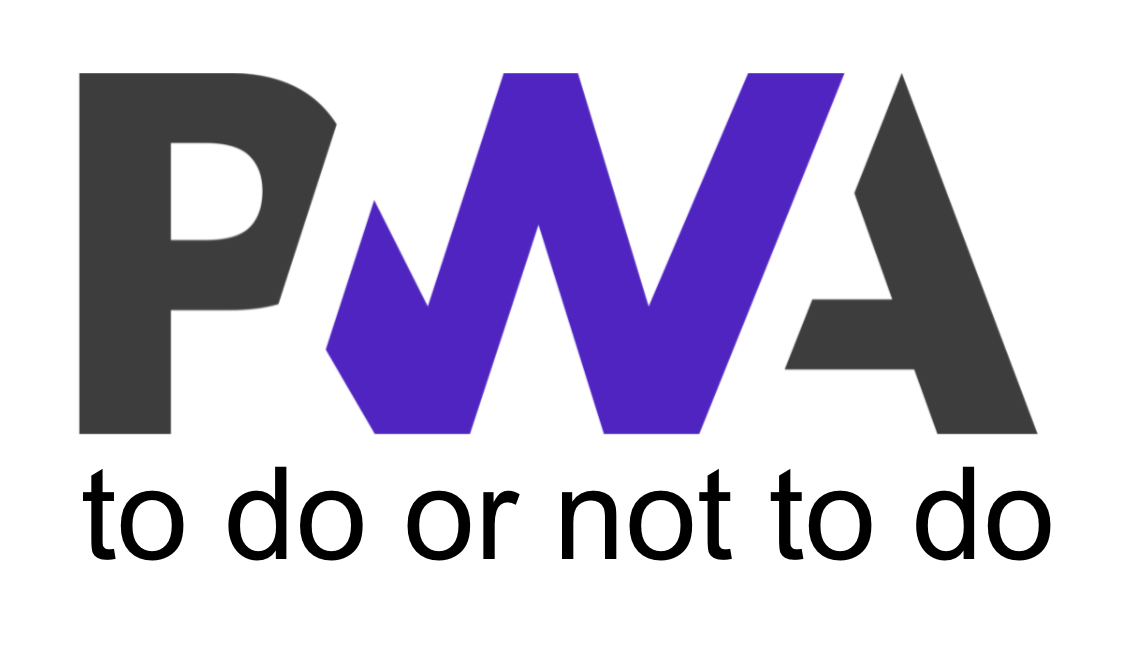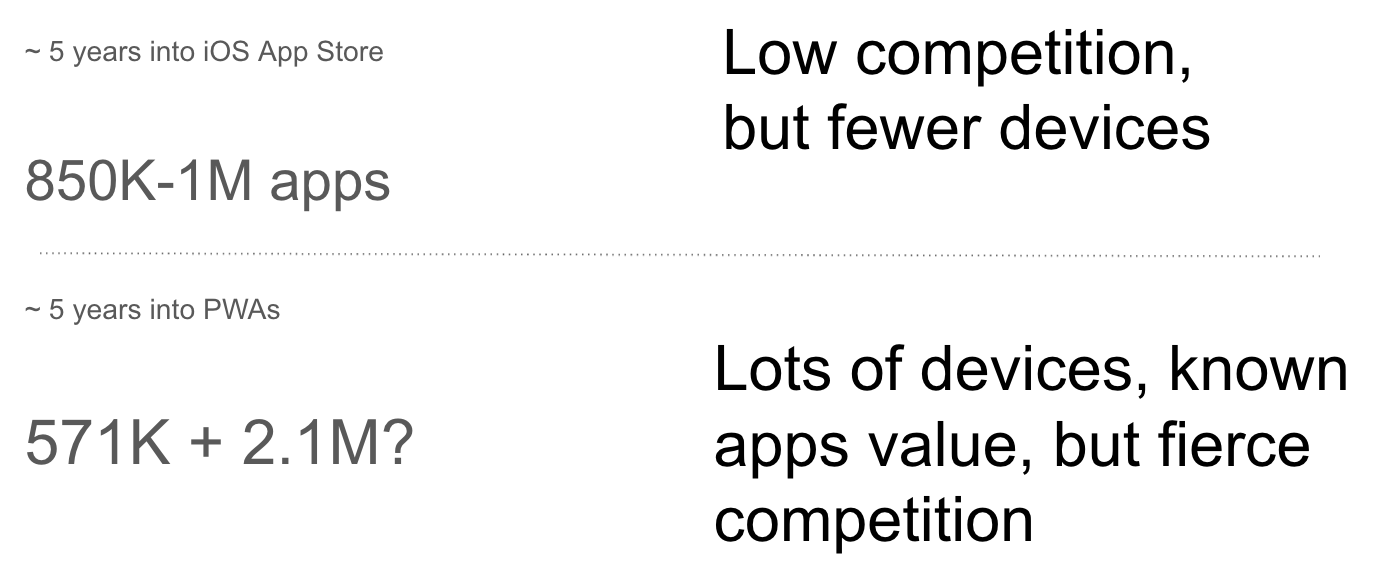Well. We learn from our mistakes. We have been always trying to develop tools, that make web apps the way WE think they should work. Not as our potentials clients see 'em work. True, we have been always talking to clients on features, but we never actually knew how the market at large is doing with the progressive web. What's the current reality?!
It took us about 9 months to deep parse about 300 million top-level domains and billions of connected web pages to learn the current state of Progressive Apps in the World Wide Web.
Done! We cataloged lots of interesting things to guide the development of our own tools.
We also gladly share the high level data with the wider market. This data was already used on several online and offline conferences related to Progressive Web.
Dig in!
It took us about 9 months to deep parse about 300 million top-level domains and billions of connected web pages to learn the current state of Progressive Apps in the World Wide Web.
Done! We cataloged lots of interesting things to guide the development of our own tools.
We also gladly share the high level data with the wider market. This data was already used on several online and offline conferences related to Progressive Web.
Dig in!

Alex Burlitsky
Chief Editor, CEO, Founder
PWAs... What's going on?


We keep hearing these questions.
Data below shows that doubts are over!
Data below shows that doubts are over!

How many of us are PWA believers?
As of September 2021:
At least 571 000 are functional PWAs, or ~0.2% of Web*
At least 2 167 000 more are in progress, or ~0.72%*
~ 100% growth in PWA density between March and Sept 2021
What does this mean?
We know the 571К working PWAs. We first looked for signs of PWA. Then checked both manifest and service worker for completion. We assigned values depending on the state. Then we collected info on keywords, industries, languages, search positions, and traffic.
* So totally about 1% have done it or are in progress. The percentage is very approximate obviously, as it relates to 300 mil domains, not the entire web.
Don't think that all these are great working applications. Sometimes people have only done tests and just kept it up.
The good thing is that the density of how many places we had to check to find 1 app is twice more than 6 months ago. So the interest is growing.
At least 571 000 are functional PWAs, or ~0.2% of Web*
At least 2 167 000 more are in progress, or ~0.72%*
~ 100% growth in PWA density between March and Sept 2021
What does this mean?
We know the 571К working PWAs. We first looked for signs of PWA. Then checked both manifest and service worker for completion. We assigned values depending on the state. Then we collected info on keywords, industries, languages, search positions, and traffic.
* So totally about 1% have done it or are in progress. The percentage is very approximate obviously, as it relates to 300 mil domains, not the entire web.
Don't think that all these are great working applications. Sometimes people have only done tests and just kept it up.
The good thing is that the density of how many places we had to check to find 1 app is twice more than 6 months ago. So the interest is growing.
How PWAs are spread in the world?
What does this mean?
To place geography we used language or the website. And English - the obvious leader, as expected. For some reason, we don't catch Chinese market at all. I am not sure why yet.
To be fair in comparison we added red bars - the number of apps per million of the population speaking that language. Some countries are doing really well, like Denmark. Others really lag behind.
What's interesting - remember how at the beginning of the PWA era, we were all talking about lighter apps, countries will low band-width, and all that?! Well, we can say that both by search results and by our platform's registrations the adoption leaders are all quite developed economies. Our educated guess is the higher cost of man-hours. Meaning that the main reason for PWA seems to be efficient dev and support, but NOT low bandwidth and device space.
To place geography we used language or the website. And English - the obvious leader, as expected. For some reason, we don't catch Chinese market at all. I am not sure why yet.
To be fair in comparison we added red bars - the number of apps per million of the population speaking that language. Some countries are doing really well, like Denmark. Others really lag behind.
What's interesting - remember how at the beginning of the PWA era, we were all talking about lighter apps, countries will low band-width, and all that?! Well, we can say that both by search results and by our platform's registrations the adoption leaders are all quite developed economies. Our educated guess is the higher cost of man-hours. Meaning that the main reason for PWA seems to be efficient dev and support, but NOT low bandwidth and device space.

How PWA numbers compare to the iOS App Store?
Is this good or bad?
The App Store did a better job in growing its numbers, but market conditions between the first 5 years of AppStore and the same years of PWAs were different.
Apple grew on low competition, but fewer devices. Progressive grew with the value of apps already proven and with lots of devices, but competition is not just from native, but also from other form of UI, like chat bots and voice.
Another kick back for PWAs was that the first apps gave the tech some unreasonably bad name. As an example, an app launch by one "beauty corporation" had lots of issues in standalone mode. We kept hearing about it for several years in all clients meetings. Sadly it was not the question of web tech, but of human attention to details. So the question is how many would there be now, if it was not for such questionable cases and not for a well known Apple Inc's attitude to Web APIs.
Obviously both the app store and PWA have some amount of junk apps, but it feels like PWAs have greater part of them.
All things considered, safe to say - no clear winner.
The App Store did a better job in growing its numbers, but market conditions between the first 5 years of AppStore and the same years of PWAs were different.
Apple grew on low competition, but fewer devices. Progressive grew with the value of apps already proven and with lots of devices, but competition is not just from native, but also from other form of UI, like chat bots and voice.
Another kick back for PWAs was that the first apps gave the tech some unreasonably bad name. As an example, an app launch by one "beauty corporation" had lots of issues in standalone mode. We kept hearing about it for several years in all clients meetings. Sadly it was not the question of web tech, but of human attention to details. So the question is how many would there be now, if it was not for such questionable cases and not for a well known Apple Inc's attitude to Web APIs.
Obviously both the app store and PWA have some amount of junk apps, but it feels like PWAs have greater part of them.
All things considered, safe to say - no clear winner.

Where PWAs are applied best? Use cases by industry.
This chart shows to which type of website each of PWAs relates to. This is not very precise as the best way would be to compare how many websites are there in each industry. However, we don't have such data for the web as a whole.
The important part is that we surely know that PWAs found its value all across the types of use cases already. In fact we know of a total of 574 different industries. The pie chart is really really diverse if you look at it ↓.


How does PWA implementation funnel look like?
These numbers are in thousands, so 571 000, and relate to the data points at the start of this report.
Over 2 740 000 web projects have started their work with PWAs → of them 1/3 did finish the manifest → of them 1/2 finished everything.
Over 2 740 000 web projects have started their work with PWAs → of them 1/3 did finish the manifest → of them 1/2 finished everything.

Year 1
Year 2
Year 3
9%
Native 1
Native 1
65%
PWA
PWA
32%
Native 2
Native 2
How does PWA compare in installation rate to native?
The results of a 3 year long experiment at the real estate management company.
9% of tenants did install their starting native app during 12 month period.
65% was for the PWA with almost the same functionality in 12 month
32% in 12 month with second native app with wider functionality
The conclusion here - PWAs provide more installs for a certain "non-must-have" kind of apps, in similar conditions.
9% of tenants did install their starting native app during 12 month period.
65% was for the PWA with almost the same functionality in 12 month
32% in 12 month with second native app with wider functionality
The conclusion here - PWAs provide more installs for a certain "non-must-have" kind of apps, in similar conditions.
What is PWA usage funnel in e-commerce?
The study of 300+ e-commerce shops shows that with the same installation conditions usage really depends on the type of a merchandise.
BEST app install rate for:
BEST return to app rate for:
BEST app install rate for:
BEST return to app rate for:
0.5 - 4% of web site traffic can install the PWA app
< 1 - 10 returns to app a month
< 1 - 10 returns to app a month
- Recurrent type merchandise, like food
- Female related products
- Recurrent type merchandise, like food
- Female related products
- Recurrent type merchandise, like food
The conclusion - PWAs are NOT really a "silver bullet" for e-commerce success. But, it seems like a must-have sales channel, as PWAs do retain a certain % of shoppers, depending on a shop type.
That's all
Lots of interesting conclusions :)
Lots of interesting conclusions :)
If you want to talk , you know where to reach me.

